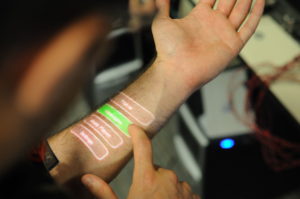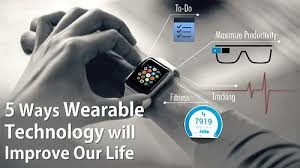Here’s an interesting piece from Ask a Tech Teacher contributor, Jane Sandwood, on the explosion of wearable technology and its place in the education ecosystem:
 How Wearable Technology is Changing Education and Easing Disabilities
How Wearable Technology is Changing Education and Easing Disabilities
As of 2015, 94% of K-12 students had a computer in their home, with 61% of the same demographic having internet access as well. With the rapid and constant growth of technology combined with the myriad of ways that it’s permeated the lives of all of society, especially youth, there’s no place where technology is wholly absent. As a result of this, wearable technology has advanced farther than phones in pockets and can include things as advanced as virtual reality headsets that allow students to experience a completely different atmosphere.
Though it can feel easy to become overwhelmed by technology, the reality is that technology of all sorts and types is here to help us, and nowhere is this more true than in the field of education. The vast majority of students are inseparable from the technology that they carry with them daily. Because of this, education must look at ways to coexist and thrive with the technology rather than shun it.
Helping to Hear
Education doesn’t stop outside of the classroom. Utilizing modern audio technology allows an incredible amount of versatility to when lectures can be accessed. Oftentimes, lectures will be entirely delivered in audio, causing there to be little to no loss in learning from the loss of the visual aspect.
Audio technology is especially portable and non-intrusive to in-classroom lessons as well. Headphones can be used to hear the lesson more clearly if students are far from the instructor or hard of hearing. There are also countless well-made translator apps that can help students that don’t natively speak the language of the lesson to understand what they’re being taught.
Solving Seeing
As important as the audio aspect of a lecture is, certain subjects require visualization, or are at least vastly improved by being able to see certain aspects. This is especially true among mathematical and scientific coursework that utilizes formulas and techniques that students will need to memorize. Students can utilize recording software along with lightweight and non-intrusive wearable cameras to record lessons and lectures so that they can be revisited.
The boons of being able to record lessons are endless. This can be an amazing tool for students with ADD or other such attention disorders that make focusing in class a struggle. Additionally, being able to revisit the lesson repeatedly allows clarification and repetition of hard-to-grasp concepts. On a final note, visual technologies can help to overcome visual disorders or disabilities that may be difficult to overcome without.
Immersing in Education
As technology advances, we often reach points where science fiction becomes reality, and few advances are a better example of this than virtual reality. The applications for this can affect every possible facet of the education experience. Utilizing virtual reality, students can visit other countries to learn geography and culture, as well as practically any other use that one can think. The possibilities are nearly endless when it comes to virtual technology.
This has led to the rise of immersive learning. This new technique allows students to work in groups and disregard distance in their education. There are few barriers to virtual reality, as by its very nature there’s no geographical or cultural barrier to cross. The only drawback is that there are relatively expensive and hard-to-transport accessories needed to use it, but once fully set up it can lead to one of the most enriching paths that education can offer.
There’s much more that wearable technology can help with than vision and hearing impairments. Wearable technology can also help make living with chronic disabilities such as diabetes or chronic pain much easier and more bearable. Without these technological advances, students may need to excuse themselves from lessons to handle issues that have arisen, and might often miss out on class entirely.
To use diabetes as an example, a student may need to leave a lesson to prick their finger and test their blood sugar. Depending on the results, the student may then need to correct their blood sugar. This causes them to miss crucial class time and miss out on information, ultimately exponentially magnifying the stress and difficulty of school.
The same student could be wearing a wearable glucose monitoring sensor that will stop them from needing to go through the process of leaving class. This certainly doesn’t eliminate the issue but makes it significantly easier and less intrusive to deal with. The same can be said for students suffering chronic pain that may be wearing electric devices that can help to diffuse or eliminate the pain, making focus and class time activities much more endurable.
Ultimately, technology will continue to advance by its very nature. As it does so, instructors and teachers can expect to see it improving the educational experiences of their pupils. Wearable technologies can help to ease the issues of students that suffer from any variety of drawbacks, whether they be impairments or disabilities that would normally make life in the classroom difficult or outright unbearable. These advances in technology are revolutionizing education and will inevitably lead to a more educated, intelligent society.
–Jane Sandwood is a freelance writer, editor and former tutor, homeschooler, and mother of two teenage daughters.
More on disruptive technologies
Virtual Reality in the Classroom: It’s Easy to Get Started
The Wild and Amazing World of Augmented Reality
Jacqui Murray has been teaching K-18 technology for 30 years. She is the editor/author of over a hundred tech ed resources including a K-12 technology curriculum, K-8 keyboard curriculum, K-8 Digital Citizenship curriculum. She is an adjunct professor in tech ed, Master Teacher, webmaster for four blogs, an Amazon Vine Voice, CSTA presentation reviewer, freelance journalist on tech ed topics, contributor to NEA Today, and author of the tech thrillers, To Hunt a Sub and Twenty-four Days. You can find her resources at Structured Learning.






































1 thought on “How Wearable Technology is Changing Education and Easing Disabilities”
Comments are closed.